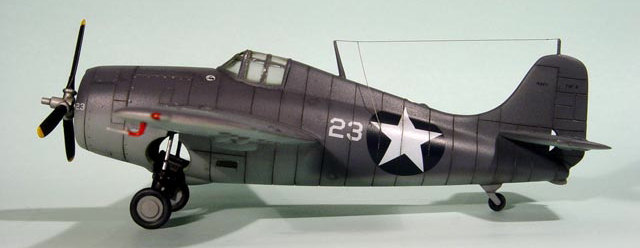
Academy 1/72 F4F-4 Wildcat
| KIT #: | 1650 |
| PRICE: | 16 PLN (about $5.50 USD) |
| DECALS: | One option |
| REVIEWER: | Pawel Piwonski |
| NOTES: |

| HISTORY |
The prototype that famous plane was machine known as a G16, designed in 1935 for
US Navy
as a proposal of fighter plane.
After acceptation in a Grumman factory prototype XF4F-1 was build. Aerodynamic
construction
related to WWI was anachronic, and in 1936 new project G-18 was accepted.
Prototype was named
XF4F-2.
Due to lack of time designers used solution used in previous project in a
fuselage and
undercarriage. Wings were new, and an engine too.
First flight was 2nd September 1937 in Bethpage. In Anacostia under US Navy
tests problems
with engine broke the test and US Navy cancelled that plane as a offer. But
after a mediations
with Aeronautics Bureau, Grumman received list needed changes, and in February
1939 new prototype XF4F-3 flew his first flight.
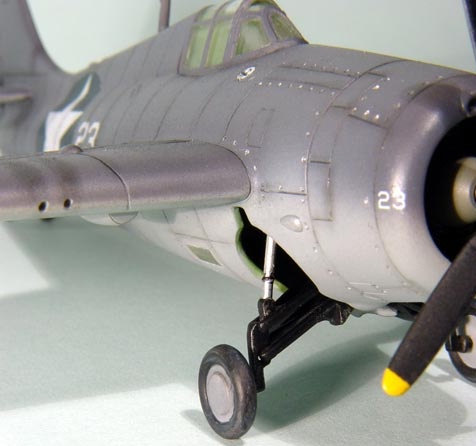 In March the same year test in Anacostia started. List errors was send to
Grumman, but US Navy ordered three next planes as a pre-production F4F-3.
Grumman sold that version as a G-36.
In March the same year test in Anacostia started. List errors was send to
Grumman, but US Navy ordered three next planes as a pre-production F4F-3.
Grumman sold that version as a G-36.
After a initial acceptation by a Aeronautics Bureau, Grumman started production
in a September 1939.Final document accepted by Grumman and Aeronautics Bureau described list needed
changes in a armament, and undercarriage.
Produced G-36 machines were ordered by French Air Force named G-36A, but only
seven were produced. French government didn't receive that planes - they were
delivered to Great Britain as a Martlet Mk.I with export version G-36B. 70
planes Martlet Mk.I were produced.
First versions for US Navy were F4F-3. First serial plane was produced in 1940,
and was delivered to
units in December 1940. Planes that version were produced till 1943.
In march 1941 Great Britain started receiving Martlet Mk.II with folded wings.
They ordered 100 planes.
First planes version F4F-3A were delivered in March 1941. Fighters ordered by
Greece were captured on
Gibraltar and were named as Martlet Mk.III.
First reconnaissance version was F4F-3. It was field modification that plane.
Minimum 10 planes were rebuild.
Prototype F4F-3 based on solution designed in a Rufe fighter. Unofficial name of
version was Wildcatfish.
Only prototype was build, and planes in a production line were rebuild into
version F4F-3.
New changes were done after a proposal of Aeronautics Bureau, two new mg's were
added, and plane had
folded wings. That version was delivered in November 1941.
Version F4F-4B was produced only for Great Britain. They named it Martlet Mk.IV.
Second reconnaissance version was F4F-4P, with the same changes like a F4F-3P.
F4F-7 was long range reconnaissance plane. It hadn't armament, and had fixed
wings.
Only 21 planes were build.
F4F-4 produced in General Motors Corp. in Eastern Aircraft Division factory was
named FM-1. Part of that version production series were send to Great Britain as
a Martlet Mk.V.
FM-2 had changed tailplane, and had external fuel tanks. Later production planes
had HVAR rocket pods.
That version was produced in years 1943-45.
Last produced version was reconnaissance FM-2P.
| THE KIT |
It is the old Academy injection kit in scale 1:72. Four sprues contain 32 parts
from grey plastic, one sprue with clear parts contains three details for
fuselage windows, and canopy. Parts from grey plastic are good quality but
detail were done in a standard from late 80's.
Clear windows and canopy are too thick. Decals are sharp and contain one option
for Atlantic unit from II WW convoy carriers.
Interior is very simple, the same as undercarriage. All details were sharp but
it should be remember the kit is done in a standard from late 80's.
| CONSTRUCTION |
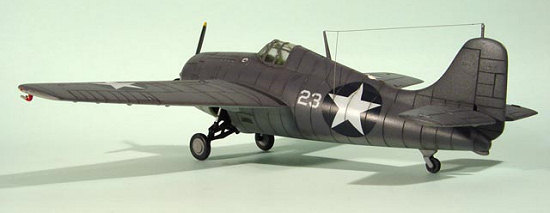 Model building I started with grinding interior, and engine details. Interior
was painted Zinc Chromate Green color. Engine was painted black and grey color
and I drybrushed it silver paint. After that engine was assembled, and mounted
into a fuselage.
Model building I started with grinding interior, and engine details. Interior
was painted Zinc Chromate Green color. Engine was painted black and grey color
and I drybrushed it silver paint. After that engine was assembled, and mounted
into a fuselage.
Windows were putted into a dedicated places. After that fuselage was assembled,
and polished places where glue was applied. Place after pilot seat was matched
using filler and tools.
 Base port was stuck on a part of plastic, and too long plastic was cut off.
Rest was filling filler and grinding with fuselage contour. The problem was with
engine
Base port was stuck on a part of plastic, and too long plastic was cut off.
Rest was filling filler and grinding with fuselage contour. The problem was with
engine
 cover which was too small loop mounted on front of fuselage. Loop was
matched with the fuselage, but it taken a time.
cover which was too small loop mounted on front of fuselage. Loop was
matched with the fuselage, but it taken a time.
Gaps for mg's were not symmetric after assembling wings parts. It needed
sticking part of plastic, polishing
 and drilling it again.
and drilling it again.
Assembling wings and elevators with fuselage was easy.
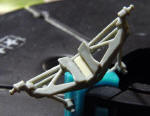 Additional part of plastic was added for strengthened undercarriage base.
Additional part of plastic was added for strengthened undercarriage base.
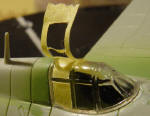 Canopy was glued with fuselage (before it pilot seat was assembled), and
additional antenna mast on tail was added by me.
Canopy was glued with fuselage (before it pilot seat was assembled), and
additional antenna mast on tail was added by me.
Model was masked and prepared for painting.
| COLORS & MARKINGS |
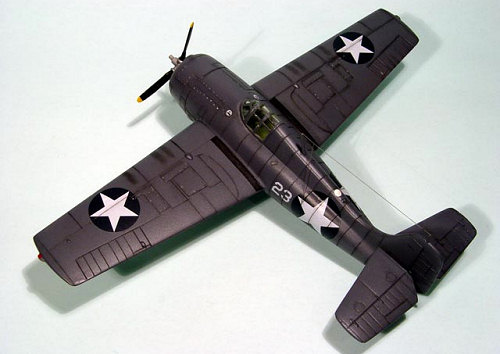 Canopy was painted Zinc Chromate Green. As first camouflage emulsion was applied
layer Agama A06 Light Grey ANA 602 on lower parts of wings, fuselage and
elevator.
Canopy was painted Zinc Chromate Green. As first camouflage emulsion was applied
layer Agama A06 Light Grey ANA 602 on lower parts of wings, fuselage and
elevator.
Upper surfaces were painted Agama A42M Blue Grey ANA 603. All colors were
applied using airbrush. I didn't use masks for applying camouflage colors.
After emulsion dried, model was painted clear glossy acryl emulsion and was
prepared for applying decals. I resigned from proposed by produced decals and
Techmod, and Kagero decals were used for my model. Decals were for personal
plane commander John Thach, from VF-3 unit, fought in Battle of Midway.
Stars were from Techmod set. Unit markings and personal number were taken from
Kagero book's decals set. Decals were easy in applying and covered one layer
glossy acryl emulsion.
Rubbed pastel was applied on metal sheet lines by brush number 00. I used
different grey colors for a better shading. That was covered one layer semi
gloss clear acryl emulsion. Model was ready for final assembling.
| FINAL CONSTRUCTION |
Prepared undercarriage was put into a prepared assembling points, and cyanoacryl
glue was applied onto the points. Wheels were glued with it after glue dried.
Propeller was glued with engine shaft.
Additionally I added antenna done from sprues extended to thin over candle.
| CONCLUSIONS |
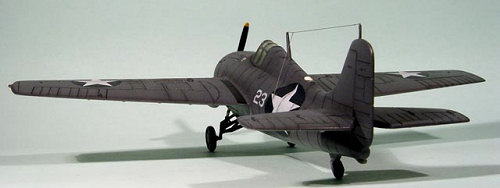 Model is simple and may be used as first model for beginners, or for training
plastic tooling. Assembling that model is nice and easy, but it has four visible shortcomings :
Model is simple and may be used as first model for beginners, or for training
plastic tooling. Assembling that model is nice and easy, but it has four visible shortcomings :
1. Too big loop mounted on front (Carburetor intake)
2. Weak undercarriage
3. Thick canopy and fuselage windows clear parts
4. Not symmetric gaps for mg's in a wings
5. Bottom edge of the canopy should be straight not curved
and ... it is "almost" like a F4F-4. "Almost" may means a lot ... ;-)
| REFERENCES |
F4F-4 Wildcat In Action, Richard S. Dann, Squadron
Signal Publications, No.191
F4F-4 Wildcat In Detail, Bert Kinzey, Squadron Signal Publications, Vol.65
F4F-4 Wildcat Walk Around, Richard Dann, Squadron Signal Publications, No.4
Grumman F4F Wildcat, Glenn Phillips, Warpaint Series No.9
Grumman F4F Wildcat, Burindo
Grumman F4F Wildcat, Andre Zbiegniewski, Krzysztof Janowicz, Kagero
May 2007
If you would like your product reviewed fairly and fairly quickly, please contact the editor or see other details in the Note to Contributors.